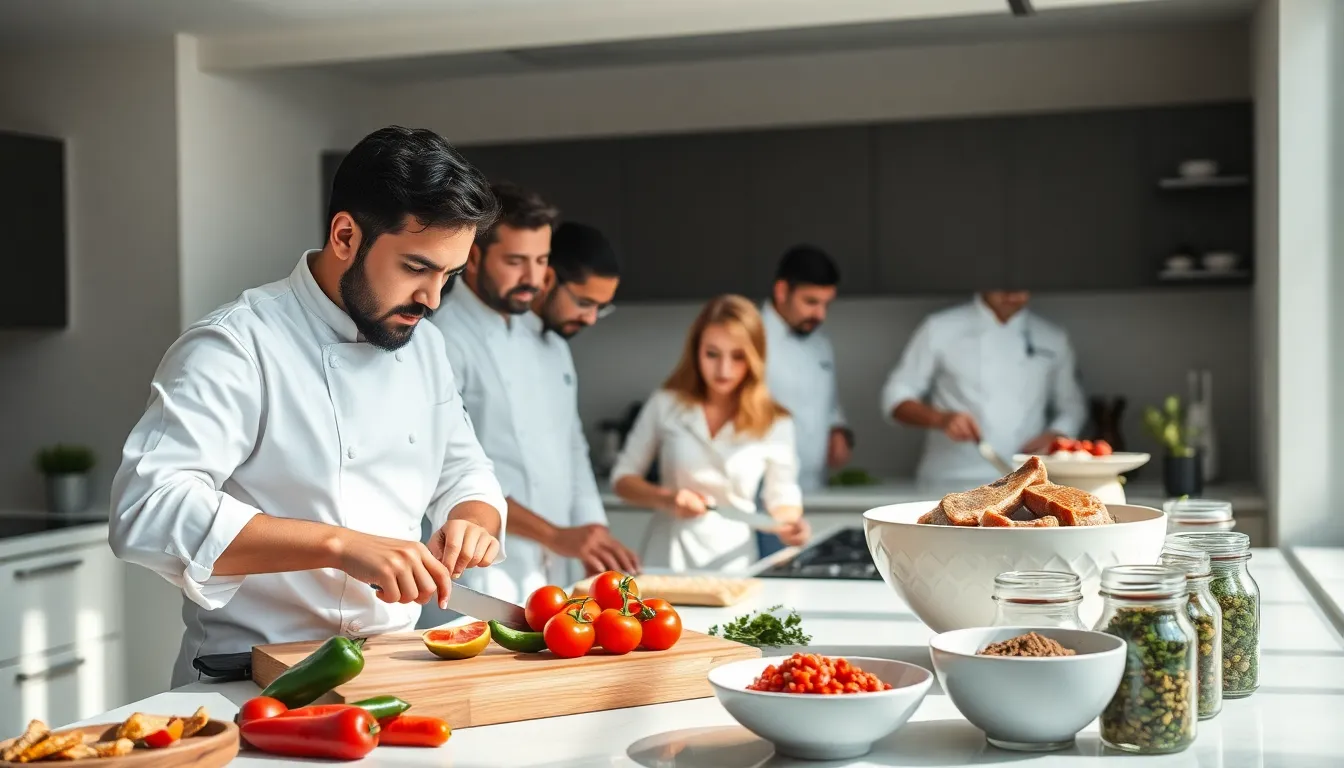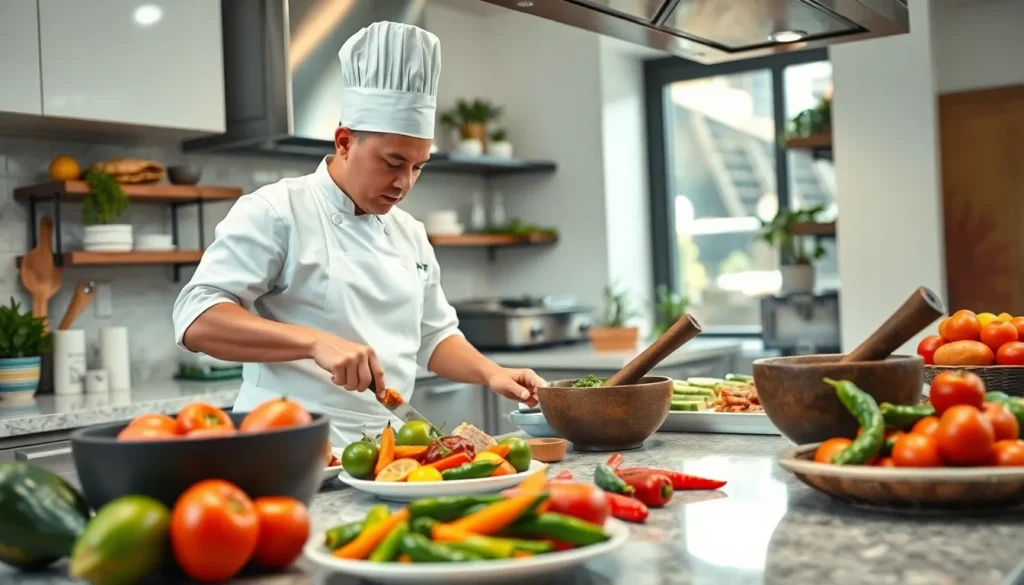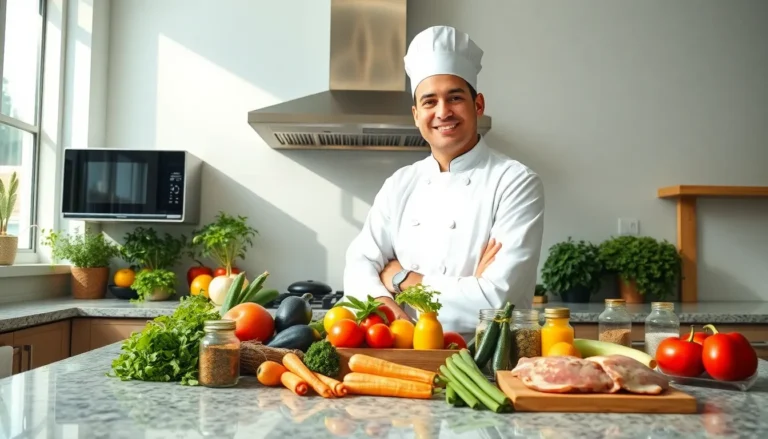Table of Contents
ToggleWhen thinking of culinary skills that tickle taste buds, Mexican cooking techniques certainly hold their own. They’re not just about throwing some ingredients into a pot, oh no. Instead, they’re a blend of rich tradition, vibrant flavors, and clever science. Imagine mastering the ability to sizzle, steam, and simmer your way to authentic dishes that transport people straight to the heart of Mexico. Excited yet? Let’s jump into these techniques that make Mexican cuisine as irresistible as a taco at 3 AM.
Fundamentals of Mexican Cuisine

Mexican cuisine is often celebrated for its bold flavors, colorful ingredients, and deep cultural roots. At its core, these fundamentals form the backbone of every delicious meal. The use of fresh ingredients, such as tomatoes, peppers, and herbs, creates a zest that defines this culinary delight. A multitude of regional variations adds to the complexity, with each area bringing unique influences, techniques, and traditions to the table.
These techniques often embrace a philosophy of balance, combining heat with acidity, richness with freshness. Whether it’s the slow cooked melt-in-your-mouth meats or the crispy, light textures of street tacos, each dish reflects the love and skill poured into it. Basic skills, like chopping, marinating, and seasoning, lay the groundwork, allowing chefs and home cooks alike to unlock the secrets of traditional recipes.
Traditional Ingredients and Their Importance
Key to understanding Mexican cooking techniques are the traditional ingredients that bring dishes to life. Corn, dried chiles, beans, and avocados are not just staples: they’re cultural icons.
Corn forms the basis of many meals and is utilized in various forms, from masa used for tortillas to hominy in pozole. Chiles, both fresh and dried, introduce layers of flavor and spice that define the character of countless dishes. When dried, chiles can range from mild to fiery, each providing a unique taste profile.
Beans, another essential ingredient, are versatile, embodying cultural significance and offering a plant-based protein source. Together, they not only nourish bodies but also feed souls, allowing families to gather and enjoy meals steeped in cultural heritage. Every ingredient tells a story, and understanding their importance enriches the cooking experience.
Key Cooking Techniques
When it comes to preparing Mexican dishes, several foundational techniques shine through.
Sautéing and Stir-Frying: A Flavorful Start
This technique focuses on cooking food quickly over high heat in a little oil, allowing ingredients to retain their color and crunch. Sautéing vegetables with garlic and onions brings out natural sweetness, setting the stage for a flavorful dish.
Grilling: The Art of Asado
Grilling, particularly in the context of asado, is an enthusiastic celebration of community and flavor. Although traditional grilling techniques may vary, using charcoal or wood brings smoky depth to meats, vegetables, and even tortillas. Perfectly charred carne asada can mesmerize anyone fortunate enough to partake.
Stewing: Slow-Cooked Perfection
Slow cooking is essential for stews, allowing spices, meats, and vegetables to meld beautifully. Traditional recipes, like mole or posole, often benefit from extended cooking times, enhancing flavors. The deeper, richer taste makes it worthwhile to plan ahead for that next family feast.
Baking: From Tortillas to Tamales
Baking plays a crucial role, particularly in the creation of iconic treats like tamales and pan dulce. Tortillas, often made fresh, are essential for countless dishes. The simple combination of masa and water creates a canvas for a myriad of flavors, so much more than just a side dish.
Unique Methods and Tools
Mexican cooking isn’t just about the ingredients. The tools and methods also contribute significantly to every dish.
Utilizing the Molcajete and Metate
The molcajete, a stone mortar and pestle, and the metate, a grinding stone, play vital roles in creating salsas and pastes. These ancient tools still find their place in modern kitchens, helping preserve authentic flavors that electric blenders simply can’t replicate.
The Role of the Comal in Everyday Cooking
The comal, a flat griddle typically made of cast iron or clay, is crucial for cooking tortillas and roasting chiles. By enhancing texture and flavor, it embodies the heart of Mexican kitchen technology: simplicity meets efficacy. Food cooked on a comal enjoys a unique taste that forms the foundation for meals across the country.
Cultural Significance of Cooking Techniques
Cooking in Mexico transcends mere sustenance. It embodies a cultural legacy that spans generations.
Sharing Food: A Cultural Tradition
Gathering around a table, sharing food, and stories means love, connection, and fond memories. Celebrations often center on food, further reinforcing the essential role cooking plays in relationships. The interactions fostered through shared meals create bonds, celebrating not only the flavors of life but also human connections.
Modern Influences on Traditional Techniques
As globalization continues to weave through cultures, Mexican cooking techniques are evolving yet thriving. Fusion cuisines emerge, blending traditional techniques with global ingredients and culinary practices. Chefs today often experiment while keeping the core of their culinary heritage intact.
Factors like ingredient accessibility and cooking technology also influence the landscape. Instant pots and sous-vide methods might find themselves alongside a comal in today’s kitchen, leading to intriguing culinary creations that honor tradition while inviting innovation. The result? A thrilling culinary adventure where the past meets the present, painting a vibrant landscape in culinary artistry.








